#gratuitous elrond content?
Photo
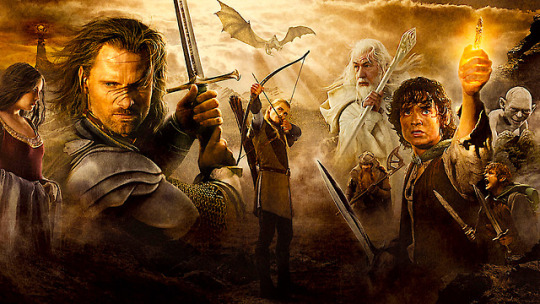



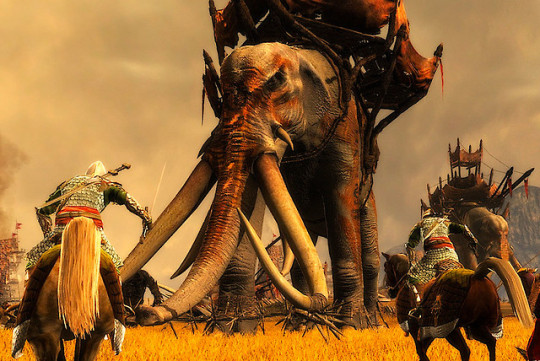
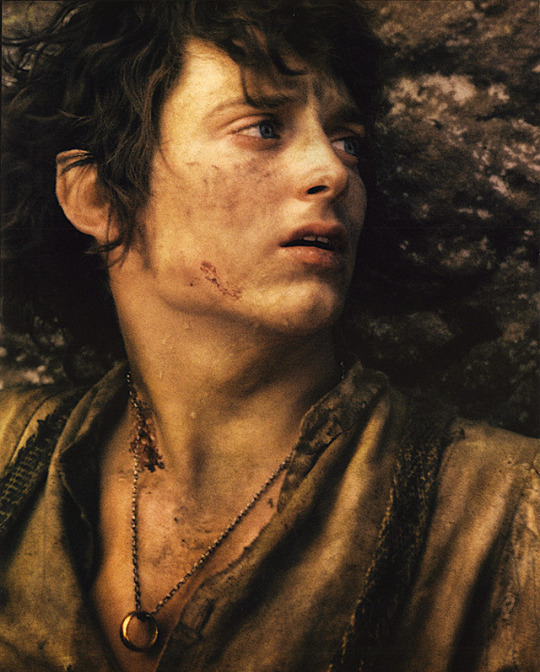
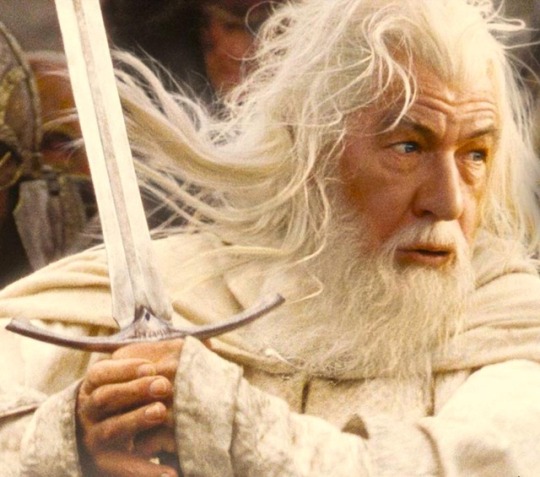
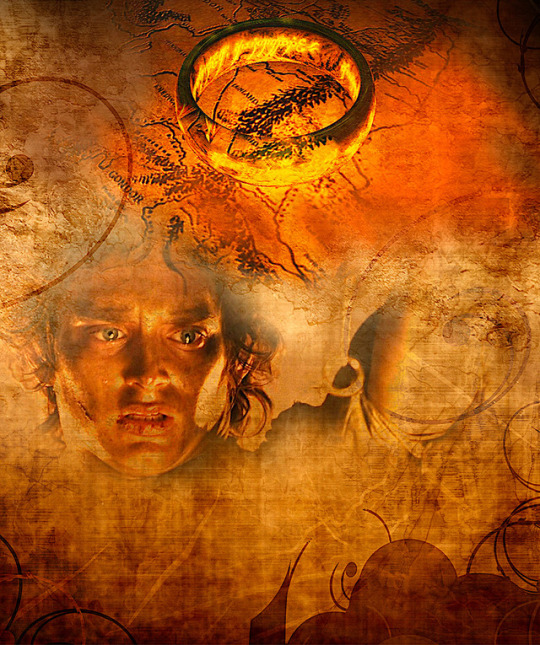
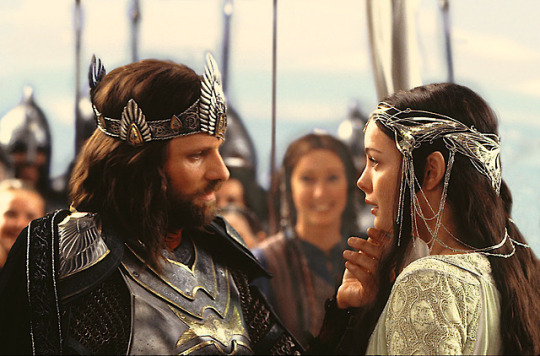
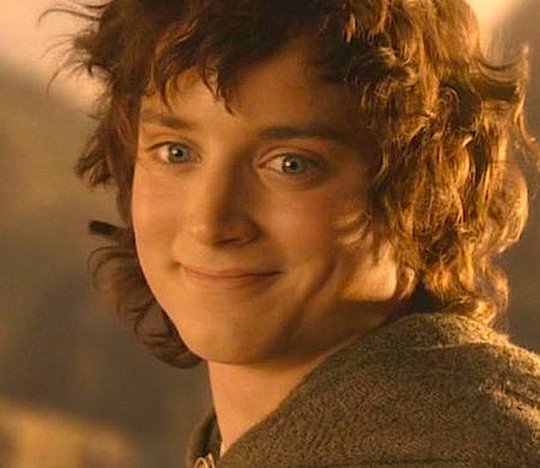
Images from The Return Of The King, courtesy of New Line Cinema
ARWEN’S CHOICE, GRIMA’S TEAR – part 3
Temptation & Forgiveness
The many Christian elements clearly present in Jackson’s Rings have been noted by some critics, including the power of sin, service to others, sharing, conversion, overcoming evil, pilgrimage, good will, salvation, vocation, love, compassion and redemption. One theme would be obvious even to a biblically illiterate viewer: susceptibility to temptation, as embodied by the One Ring’s effect on Bilbo, Smeagol, Deagol, Saruman, Boromir, Denethor and Faramir. This motif is presented at its most complex in the various stages of temptation Frodo goes through.
Forgiveness is especially apparent in several places: Frodo’s treatment of Gollum; Gimli’s change of heart regarding elves; Aragorn’s acceptance of Legolas’ apology; and Theoden’s kindness to the repentant Grima. The self-sacrifice, loyalty, servant nature and unconditional friendship of Samwise are a beacon throughout the film. Christ’s devotion to his mother Mary is echoed when Aragorn honors his own deceased mother’s statue (which is itself an obvious reference to Catholic veneration of the Virgin).
Providence
Divine providence rears its majestic head in several places. Gandalf tells Frodo: “Bilbo was meant to find the Ring; and you also were meant to have it. And that is an encouraging thought.” As Aragorn lies grievously wounded, Arwen’s spirit hovers over his body. Deep in Mordor, Sam looks up and sees a star through a break in Sauron’s poisonous cloud, and says: “There is light and beauty up there, Mr. Frodo, that no shadow can touch.” The White Tree finally blossoms, a none-too-subtle reference to the Tree of Life. Frodo and Sam are rescued by Gandalf and the eagles, as if by angels.
The filmmakers also add a surprisingly biblical twist to Theoden’s release from mental and spiritual subjugation: the king is literally exorcised, freeing him from being directly possessed by Saruman. Whether this was done because Jackson knew it was a very Catholic concept, or simply because it was a way cool cinematic device, is a matter of speculation.
Christ Figures
Just as Sauron, Saruman and the Witch King are clearly symbolic of Satan, and the Black Riders represent demons, the film also presents several obvious Christ figures: Gandalf, Aragorn and Frodo. Gandalf is explicitly called The White Rider – invoking the horseman of Revelation 19:11. As Gandalf the Grey, he falls at Khazad-dum, his arms spreading out to form a cross; he wrestles the Balrog of Morgoth (Satan) into the abyss (hell); he is later reborn as Gandalf the White, a more powerful Istari than he has ever been. In his new form, he is able to drive the fearsome Nazgul away with the white light issuing from his staff.
In the book, after the battle of Pelennor Fields, Aragorn demonstrates his gentler skills in the Houses of Healing. Tolkien writes: “The hands of the king are the hands of a healer – and so shall the rightful king be known.” While Jackson doesn’t overly emphasize this, he shows Eowyn being nursed by Aragorn – accompanied by a peaceful and lyrical song by Liv Tyler. Early in the film, Aragorn also uses his healing skills to help Frodo. There is also a very touching moment near the end, when Aragorn tells the hobbits: “You bow to no one.” He bows his knee to them, echoing an aspect of Christ: “He humbled himself.” His humility is also demonstrated by his earlier willingness to serve another king, Theoden, even though he is a monarch waiting to ascend to his own throne.
Mercy & Sacrifice
Frodo repeatedly shows mercy to Gollum, hoping to somehow help reverse the effect of the One Ring and start the pathetic creature on the road to regeneration. Frodo also embodies the punishment Christ endured when He was “wounded for our transgressions.” By the time the hobbit gets to Mount Doom, he is a devastated shadow of his Shire self.
The crucial moment, where he is stricken by the poison of evil, comes in act one – when he is wounded by the Witch King on Weathertop. Jackson reminds us of this moment several times, through flashbacks and other references. Toward the end, Frodo tells Sam: “It’s never really healed.” The price he pays in gaining the victory over Sauron’s evil, through his sacrifice, echoes the price paid by Jesus on the Cross.
Rebirth & Eternity
Resurrection is also very much evident throughout the film. Gandalf is literally raised from the dead. The injured Aragorn is restored by a mystical kiss from Arwen’s spirit; and the future king symbolically conquers death by walking the Paths of the Dead. At the Grey Havens, the last elves in Middle-Earth board a ship to the Undying Lands (also referred to by Tolkien as the Blessed Realm, the home of the Valar).
Frodo tastes death symbolically several times: getting stabbed by the morgul blade, whose poison could turn him into a wraith; succumbing to the Ring’s power on several occasions; falling into a swamp filled with demonic ghosts; and being struck down by Shelob’s sting. But all of these are overthrown by the Grey Havens scene, which represents his resurrection. “We set out to save the Shire,” he says, “and it has been saved – but not for me.” The only way out for him is to pass from Middle-Earth to the elves’ paradise across the sea. Thereby, “death is swallowed up in victory.”
The film only briefly alludes to the Undying Lands, with no detailed explanation of the term; but the concept of eternal life is touchingly enunciated by Gandalf, in a wonderful passage taken almost verbatim from the climax of the book (describing Frodo approaching the Undying Lands). As they sit barricaded in Minas Tirith, with enemy forces closing in, the wizard says to Pippin: “No, the journey doesn’t end here. Death is just another path, one that we all must take. The grey rain-curtain of this world rolls back, and all turns to silver glass. And then you see it … white shores – and beyond them a far green country, under a swift sunrise.”
Arwen’s Importance
Many critics and purists have complained about the increased role given to Arwen. Initially, the perception was that the filmmakers were simply tacking on a gratuitous romance to appeal to ‘the female demographic.’ But such talk died down when it became known that most of the Arwen scenes were taken directly from material in Appendix A of the book. Curiously, most Christian commentators don’t seem to have picked up on the Christian elements that virtually saturate the Aragorn/Arwen subplot.
In my view, this subplot was the most significant script decision taken by Jackson and company; indeed, it was a stroke of genius. By expanding Arwen’s role, based faithfully on the back story outlined in the Appendices, the scripters greatly increased the Christian content; they added a strong metaphorical element which was only implied in Tolkien’s actual narrative. It makes me wish Tolkien had woven the details into the narrative instead of relegating them to the appendix.
Arwen’s Grace
A summary of the Arwen/Aragorn story arc will help clarify my thesis. The first hint of the subplot occurs in act one, before Arwen appears in the film. Beside a campfire, Aragorn softly sings a song about the legendary elfmaiden Luthien, who gave her love to the human Beren, thus relinquishing her immortality. Frodo asks whom the song is referring to; Aragorn’s response subtly indicates he is thinking of his own immortal lover. Arwen is introduced soon after, and rescues Frodo from the Black Riders; as his wound overcomes him, she prays: “What grace is given me, let it pass to him; let him be spared.” In Rivendell, Arwen gives Aragorn encouragement, renews her vow to ‘bind herself’ to him, and bestows her Evenstar jewel upon him. He goes off on the quest, after a somber parting.
In act two, there is a flashback to Rivendell. The lovers share a tender moment; then Elrond exhorts Aragorn to give Arwen up, thereby allowing her to leave Middle-Earth and keep her immortality in the Undying Lands. Reluctantly, Aragorn breaks off the relationship; but she insists that he keep the Evenstar. Later, he is severely wounded in the warg attack. As he lies stricken, she materializes above him, conferring a blessing and a phantom kiss upon him. We hear her voice: “May the grace of the Valar protect you”; the Valar are the Ainur, the Holy Ones, the first creations of Tolkien’s Creator, Iluvatar – in other words, angels.
Arwen’s Destiny
The scene switches to Rivendell. Arwen refuses to leave Imladris with the other elves, determined to be reunited with her lover. Elrond then tells her what will become of her after Aragorn meets his inevitable mortal end; in a vision of her future, Arwen sees herself mourning the passing of her beloved, as her father paints a devastating picture of the black-clad widow wandering desolate, alone in a barren forest. Arwen capitulates, and leaves Rivendell with the other elves.
In act three, Arwen is heading through the forest with her elvish escort. She sees a vision of an older Aragorn embracing his young son, who is wearing her Evenstar jewel. She returns to Rivendell, and confronts Elrond about this alternate future; she chooses to stay in Middle-Earth, to bring her son into the world – and exhorts her father to reforge Narsil, the shattered blade that cut the Ring from Sauron’s hand 3,000 years before. Elrond sadly accepts her choice, comforts her and laments: “The life of the Eldar is leaving you.” Meanwhile, in his tent, Aragorn has a dream of the Evenstar being shattered.
Elrond gives Aragorn a gift: Anduril, the reforged Sword of the King. He also gives him the sad tidings that Arwen is dying – her destiny now mysteriously tied to the fate of the One Ring. Aragorn later uses a palantir to confront Sauron – who shows him a vision of his dying lover; the Evenstar shatters, this time for real. Aragorn takes up Anduril, and goes to confront Sauron’s army at the Black Gate; the Ring, and Sauron, are destroyed. At Aragorn’s coronation, he is reunited with his lover. The reunion, while joyous, is rendered even more poignant by the bittersweet implications of Arwen’s new mortal status.
Love & Hope
In total, Arwen is onscreen a fairly small amount of time; but it feels much more substantial. Her appearances are paced just right, and her importance to Aragorn resonates throughout the film. Their story is heavily imbued with Christian meaning, as web critic Abercius has eloquently pointed out at CatholicQandA.com. Aragorn is willing to sacrifice Arwen’s companionship to save her from a life of war and despair – loving her “as Christ loved the church, and gave Himself up for her.” Yet, he never totally gives up on his love for her, continuing to wear the Evenstar.
Indeed, he is the very embodiment of Christian hope, in Tolkien’s view; the author names him Elessar, which means ‘the Renewer’, and Estel, meaning ‘hope’. While the film doesn’t clarify these ideas, Aragorn still embodies them. At Helm’s Deep, facing overwhelming odds, he tells a boy soldier: “There is always hope”; when all seems lost, he motivates Theoden to ride out and meet the enemy regardless; and his short rallying speech to the troops at the Black Gate is truly inspiring.
Ultimate Sacrifice
In her own way, Arwen is also a true Christ figure. She, too, humbles herself; and she also makes the ultimate sacrifice. She is free to go to the Undying Lands, but chooses not to – partly motivated by the vision of the child she could only have if she stays with Aragorn. She sacrifices her immortality to bring the child into existence. While her motivation is a combination of romantic love, and love for the child, the fact is that she lays her life down to save another’s life. What could be more quintessentially Christ-like?
In some respects, Arwen is the purest element in the entire film, an embodiment of nobility, grace, loyalty and love. Her story adds extraordinary emotional and spiritual power to the film. By increasing her role, Jackson and his co-scripters actually improved on Tolkien in a profound way – and that is no mean feat.
For Fanatics Only?
Finally, here’s where we separate the elves from the dwarves. At the risk of being dismissed as a hopeless fanatic, I have to say that The Lord Of The Rings is best appreciated when it is watched in an all-day marathon; the story has greater immediacy, momentum and accumulative emotional impact. Some key elements resonate more intensely throughout the saga. Indeed, watching the complete film in one sitting (with breaks for second breakfast and afternoon tea, of course!) greatly enhances one’s appreciation of some of the most important elements of this sprawling narrative.
These include: the evolution of the relationship between Frodo and Sam; Smeagol’s struggle against his alter-ego, Gollum, and his ultimate capitulation to evil; the growth of Merry and Pippin, from juvenile clowns to seasoned warriors; the dire significance of Frodo’s wound; the relationships between Denethor and his sons; Aragorn’s progress from uncertain exile to confident monarch; the weight of Arwen’s acceptance of mortality; Theoden’s evolution from slave of Saruman to courageous champion; Gandalf’s progression from lovable Grey bungler to imperious White commander; Frodo’s view of Smeagol, going from hatred to pity to mercy; the importance of the Shire as the hobbits’ idyllic refuge from the world; Eowyn’s progression from sheltered royal to shieldmaiden; and Frodo’s evolution from carefree and complacent hobbit to haunted, battle-scarred outsider.
The shorter version is probably best for a day-long marathon, of course, simply because of the daunting length of the extended edition; but the latter is well worth devoting a day to, for the maximum experience. For the less venturesome, the film can also be split very nicely into two parts and viewed on consecutive days. In my opinion, it’s best to end part one after Saruman sends his army of Uruk-hai off to Helm’s Deep; and to begin part two with Merry and Pippin seeing Saruman’s army in the distance. A Galadriel monologue soon after that scene effectively encapsulates the key points of the story’s first half.
Missed Opportunity
After all is said and done, there’s only one thing Jackson could do to improve upon his work: release the full extended film worldwide as a big-screen special event – preferably in Imax theatres. The extended editions of Fellowship and Towers were given a brief theatrical run in 2003; but as far as I know, aside from a few limited presentations, the extended finale has never been widely shown to the public on the big screen internationally. Surely, this is a missed opportunity.
Now that he has gotten his King Kong remake, The Lovely Bones and The Adventures of Tintin out of his system, and especially since The Hobbit has finally become a reality, I hope Jackson may consider doing a big-screen edition of the complete Rings saga (maybe even a 3D version, if it is done properly). New Line Cinema would be wise to do it now that the complete Hobbit trilogy has run its course; indeed, I would love to see a special presentation of both trilogies in the theatres.
Supreme Masterpiece
Speaking of The Hobbit, much has been written about the supposed failure of Jackson to remain faithful to the book. I have to disagree with that assessment, and have done so at great length in my review (see link below). Personally, I think the Hobbit series is surpassed only by the Rings Trilogy, as a supreme work of fantasy. I can't think of any production unit that could have done a better job than Peter Jackson and his colleagues, and I am greatly looking forward to further flights of fancy from those quarters. It's fun to ponder how the Kiwi Wizard could possibly top himself.
We might dare hope that he and his team could someday tackle The Silmarillion. It is a rather unwieldy book, but a great film could be made by focusing on the creation myth of Iluvatar and the Ainur; the theft of the Silmarils; the villainy of Sauron’s mentor, Morgoth; the tragedy of Beren and Luthien; the cataclysmic destruction of Numenor; and Sauron’s defeat in the War of the Last Alliance. Tolkien’s Children Of Hurin would also make a fine film – albeit a rather gloomy one, but powerful nonetheless. However, considering the intransigence of the Tolkien Estate, it is highly unlikely Jackson would ever get the movie rights.
In conclusion: It is indeed no exaggeration to call The Lord Of The Rings a supreme masterpiece. While it has a few miniscule flaws, it is nevertheless one of the very greatest accomplishments in the history of film. It is highly doubtful that it could ever be surpassed as a spectacle. In my mind, the only thing that could conceivably trump it would be a faithful adaptation of the Book Of Revelation – done with the same state-of-the-art technology, craftsmanship and imagination, by someone with money willing to invest it. Is George Lucas listening? Just kidding! How about Spielberg?
For an archive of outstanding Rings-related videos, click here for the APPENDICES:
http://musemash.tumblr.com/post/181194210475/the-rings-trilogy-multi-facet-appendices-in
VINDICATING A SPLENDID HOBBIT'S TALE
https://www.facebook.com/fugue999/photos/a.337095876312460/1040775709277803/
1 note
·
View note